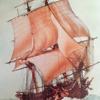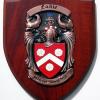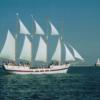MORE HANDBOOKS ARE ON THEIR WAY! We will let you know when they get here.
×
-
Posts
1,584 -
Joined
-
Last visited
Reputation Activity
-
 albert reacted to Mahuna in Dunbrody by Mahuna - FINISHED - 1:48 - Cross-Section - Irish Famine Ship
albert reacted to Mahuna in Dunbrody by Mahuna - FINISHED - 1:48 - Cross-Section - Irish Famine Ship
Part 6 – Frame Installation
I was going to begin the description of the frame construction process, but I’ve been thinking a lot about the installation of the frames, and I think I’ve come up with a workable approach. I’d appreciate any comments, suggestions for improvement, cautions, etc., that anyone cares to make.
The frames are separated by approximately 5 inches (actual), which would be slightly less than 7/64 at 1:48 scale. This doesn’t leave a lot of room for clamping. I do have some small machinist’s clamps (from Lee Valley woodworking) that I’ll use.
I decided to use a flat piece of wood mounted vertically on the shipway as a clamping fixture. The wood is 3/32 thick and I made sure that it lay flat and that the bottom edge was flat against the shipway. The length of this fixture is just greater than the span of the frame at the second futtocks (this is the extent of the largest sided dimension of the frame). I cut out clearance for the keel and the pieces holding the keel.
As Druxey already suggested, I want to use a cross-spall to check that the frame is perpendicular side-to-side. In thinking about how to secure this cross-spall, I decided to pin it to the frame, using the lower of the two pinning holes at the top of the frame. This will position the cross-spall within 1/8 inch of the string used to mark the centerline, making it easy to line up the centerlines. Since most (possibly all) of the frames will be of the same width at top, I can reuse the cross-spall. Pins will make it easy to mount and unmount the cross-spall, so I cut some pins down to a length that will not interfere with adjacent frames, and CA glued them to the spall so I wouldn’t lose them.
The ends are marked S for starboard and P for port, to avoid any fit issues, and the centerline is marked on all four sides of the spall. The following photo shows the spall attached to a frame.
A test mount of a frame, aligning the centerline of the cross-spall with the centerline string seemed to work.
So, hopefully this is the approach I will use for mounting the frames. As I said earlier, though, I am very open to any comments, criticisms (I know they’re constructive), or suggestions.
-
 albert got a reaction from GLakie in Cutter Cheerful 1806 by rafine - FINISHED
albert got a reaction from GLakie in Cutter Cheerful 1806 by rafine - FINISHED
Congratulation Bob your model is fantastic.
-
 albert got a reaction from Canute in Cutter Cheerful 1806 by rafine - FINISHED
albert got a reaction from Canute in Cutter Cheerful 1806 by rafine - FINISHED
Congratulation Bob your model is fantastic.
-

-
 albert reacted to rafine in Cutter Cheerful 1806 by rafine - FINISHED
albert reacted to rafine in Cutter Cheerful 1806 by rafine - FINISHED
My Cheerful is now complete. I have mounted the anchors, which was the last remaining work to be done. As I indicated earlier, I was having trouble coming up with a mounting plan with which I was happy. My solution, after reviewing photos of contemporary models, and trying out various configurations, was to mount the two anchors differently. On the congested port side, I chose to go with lashing the anchor to two timberheads, without a cable or cat block. On the more open starboard side, I went with the anchor hanging from the cat block, with a cable leading back to the windlass and being tied off to it, as shown on the Rogers collection model.
I would like to take this opportunity to thank all of you on MSW who have followed this build and provided the kind of support, encouragement and friendship that we have come to expect from the members of this site. I also want to thank Chuck for coming up with this project and the products to support it. It has been one of the most enjoyable builds that I have done.
Attached are photos of the anchor installation and the model's completion portraits.
For those interested, my next build will be the Caldercraft Granado. A full description of the reasons for the choice and my plans for the build will be set out in the log that I will be starting today in the kit build section ( how's that for a cheap ploy to get all of you to look at the new log ).
Bob
-
 albert reacted to druxey in Greenwich Hospital barge of 1832 by druxey - FINISHED - 1:48 scale
albert reacted to druxey in Greenwich Hospital barge of 1832 by druxey - FINISHED - 1:48 scale
Thanks for dropping by, everyone.
The outer sides of the coach have been completed and gilded. The coach is only test-fitted together at present. I'm now in the process of panelling the inner sides and refining the fit of the corners of the coach. The latter needs particular care: take too much material off a corner and....
The door hardware has been added. The door knobs are of brass wire whose ends have been melted. If done correctly, the ends of the wire will form a small spherical ball. The 'bronze' hinges are pieces of bamboo treenail and paper, acrylic painted.
-
 albert reacted to JerryGreening in Bonhomme Richard by JerryGreening - 1:48 scale
albert reacted to JerryGreening in Bonhomme Richard by JerryGreening - 1:48 scale
The framing continues, though I took a little break from working on the hull to play with the little Unimat lathe a bit. I gave turning some cannon barrels a go.
-
 albert reacted to EdT in Young America 1853 by EdT - FINISHED - extreme clipper
albert reacted to EdT in Young America 1853 by EdT - FINISHED - extreme clipper
Young America - extreme clipper 1853
Part 157 –Deadeye Chain Backing Plates
Each of the larger channel chains is bolted to the hull through a backing plate (or preventer plate) for additional support. These larger chains anchor the chain deadeyes for the lower shrouds and topmast backstays. Chains supporting lighter rigging have a single bolt and no backing. These plates are about 3’ long and about 1” thick with bolt holes at each end. They are bent in an offset to fit over the chains. The chain fabrication will be covered later.
The first step in making the numerous required plates was to solder brass tubes to the edges of a brass plate. This fabricated piece is shown in the first picture after pickling and buffing to remove oxide.
I used wire silver solder and black paste flux for this. The tubes were held for soldering with pins. I used a small oxy-propane torch on the first side, then running out of O2 used a larger propane torch on the other side. I normally use a small propane torch but in this case the large joints benefited from the extra heat.
The individual backing plates were then sliced off this strip in the circular saw using a screw slotting blade. They were sliced off slightly over thickness. In the next step the plates were filed smooth on one side, then flipped and filed to final thickness on the other. The next picture shows this being done with the aid of a holding fixture.
The fixture has two milled slots, one slightly deeper for the first filing, the second milled to the final thickness for final sizing. Both sides were polished with abrasive sticks. The next picture shows plates before and after filing.
Each plate was then bent as shown in the next picture to form the offset.
Finally, the plates were pickled in acetic acid (white vinegar), given a degreasing bath (TIVA®) and submerged in a very dilute solution of Birchwood Casey® blacking. They are shown after drying below.
Around 50 of these are required, but quite a few extras were made to account for expected attrition at each step and shape issues..
Chain fabrication and the 16” deadeye itting will be covered in the next part.
Ed
-

-
 albert reacted to Rustyj in Cutter Cheerful 1806 by Rustyj - FINISHED - 1:48 Scale
albert reacted to Rustyj in Cutter Cheerful 1806 by Rustyj - FINISHED - 1:48 Scale
Hi All,
Continuing on I’ve completed sanding the bulkheads to the desired thickness.
The false deck was cut out of some 1/16” cherry I had on hand. I made it out
of two pieces and after adjusting and fitting it I had a minor gap in the middle
which I filled with wood filler.
Once that was completed I planked the bulkheads and painted it with Red Ochre.
Here you can see that the cap rail has been completed and the margin planking has been started.
That’s the fun stuff.
Well the Admiral and I have purchased a different home and I am now in full
renovation mode. Sadly by the end of this month (April) the workshop will
shut down until the move has been completed and a new workshop constructed.
The new shop will be in a 12x20 section of the basement that is currently unfinished.
So it is going to be a happy/sad time coming up. It will be thrilling to double my
workshop space but shutting down the shop for 3 months or more will really be annoying!
So I will be getting done what I can in between work and the renovations till the end of
the month.
-
 albert reacted to druxey in Greenwich Hospital barge of 1832 by druxey - FINISHED - 1:48 scale
albert reacted to druxey in Greenwich Hospital barge of 1832 by druxey - FINISHED - 1:48 scale
Thanks once more for the likes and comments, everyone.
I had to re-do the side of the coach. I found that I had cut the lights to the wrong depth. In addition, the lights were uneven in width. So, a second round.
When dealing with tiny pieces, I've found it easiest to leave them over-length to glue them on (top photo). I then use a chisel to cut the pieces to exact length. The top and bottom pieces of the panel frame were cut a little overlength, then sanded using a sanding stick to trim them to exact dimension (second photo).
The inner side of the piece has had card strips glued on to leave channels for the glazing (third photo). In this case I shall be using mica. This is a naturally occurring mineral that is fairly transparent. It can be peeled into very thin layers and cuts easily. The pieces will be slid into place from above before the roof is installed. The cutaway at the bottom of the side is because the hull curves inward here and this allows for the changing interior contour.
The last photo shows the work to this point. Next will be the inside panelling and the other side piece.
-
 albert reacted to Niklas in Le Rochefort 1787 by Niklas - 1:36
albert reacted to Niklas in Le Rochefort 1787 by Niklas - 1:36
And here a quick update. Having fun with my latest and favorite toy, the milling machine.
-
 albert reacted to Niklas in Le Rochefort 1787 by Niklas - 1:36
albert reacted to Niklas in Le Rochefort 1787 by Niklas - 1:36
Hi!
Been holding on to this monograph for a while now and finally decided to give it a try. I will mostly use pear wood, maybe switch to boxwood when it's time to plank the hull - I probably have a year or two before I need to decide that...
Here is a quick start:
Niklas
-
 albert reacted to Mahuna in Dunbrody by Mahuna - FINISHED - 1:48 - Cross-Section - Irish Famine Ship
albert reacted to Mahuna in Dunbrody by Mahuna - FINISHED - 1:48 - Cross-Section - Irish Famine Ship
The process for building the frames is fairly long and complex, and I'm still trying to put it down in a form that makes sense to everyone who looks in.
In the meantime, I've completed the first 7 framesets or frame pairs and I wanted to see how they look on the keel. The frames are NOT permanently in place, they're simply laid on the keel. The notch in the bottom of each frame is fairly tight, so it holds them in place. As I install them permanently I may need to loosen the notch here and there for proper alignment. I'm still thinking through an effective way to make sure they're correctly aligned when installed.
Here's what they look like in their temporary install:
Thanks everyone for the likes and comments.
-
 albert got a reaction from Elijah in Dunbrody by Mahuna - FINISHED - 1:48 - Cross-Section - Irish Famine Ship
albert got a reaction from Elijah in Dunbrody by Mahuna - FINISHED - 1:48 - Cross-Section - Irish Famine Ship
Hi frank, great start.
-
 albert got a reaction from Elijah in HMS Atalanta 1775 by tlevine - FINISHED - 1:48 scale - from TFFM plans
albert got a reaction from Elijah in HMS Atalanta 1775 by tlevine - FINISHED - 1:48 scale - from TFFM plans
Hi Toni, wonderful work.
-
 albert reacted to Dan Vadas in HMS Vulture 1776 by Dan Vadas - FINISHED - 1:48 scale - cross-section - from TFFM books
albert reacted to Dan Vadas in HMS Vulture 1776 by Dan Vadas - FINISHED - 1:48 scale - cross-section - from TFFM books
I've also made all the Gratings. Unlike the "store bought" gratings these are to the right scale. The athwartships pieces are a mere 3/4" thick (real size) which translates down to 0.38mm in 1:48 scale. All the pieces were cut and mortised using the Byrnes Table Saw and Micrometer Gauge :
I made a Jig to aid in assembly :
Danny
-
 albert got a reaction from Elijah in HMS Atalanta 1775 by tlevine - FINISHED - 1:48 scale - from TFFM plans
albert got a reaction from Elijah in HMS Atalanta 1775 by tlevine - FINISHED - 1:48 scale - from TFFM plans
Hi Toni fantastic work.
-
 albert reacted to Siggi52 in HMS Dragon 1760 by Siggi52 - FINISHED - Scale 1:48 - English 74-Gun ship
albert reacted to Siggi52 in HMS Dragon 1760 by Siggi52 - FINISHED - Scale 1:48 - English 74-Gun ship
Hello again,
a friend send me this picture of the now new restored Victory. Maybe they have seen my blog?
This is my lobby
Regards,
Siggi
-
 albert reacted to navymast in Burford 1722 by navymast - scale 1:48 - Suspended
albert reacted to navymast in Burford 1722 by navymast - scale 1:48 - Suspended
Halves are ready. Ahead work with emery cloth.
-
 albert got a reaction from Canute in HMS Naiad 1797 by GDM67 - 1:60 - using Ed Tosti Books
albert got a reaction from Canute in HMS Naiad 1797 by GDM67 - 1:60 - using Ed Tosti Books
Very nice.
-

-
 albert got a reaction from mtaylor in HMS Naiad 1797 by GDM67 - 1:60 - using Ed Tosti Books
albert got a reaction from mtaylor in HMS Naiad 1797 by GDM67 - 1:60 - using Ed Tosti Books
Very nice.
-

-








